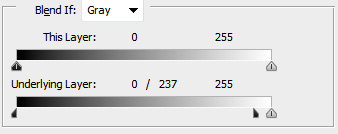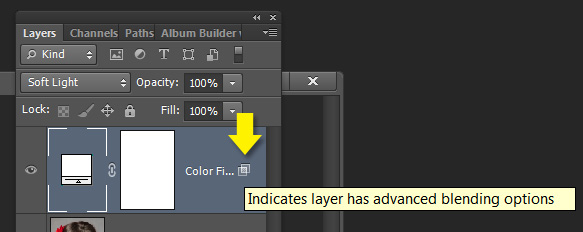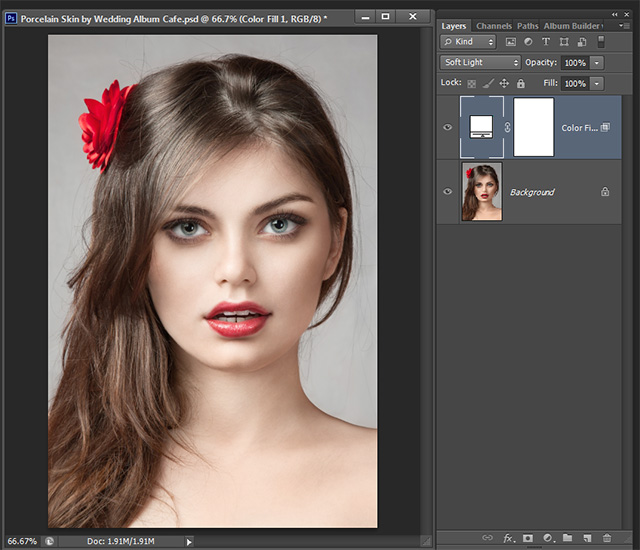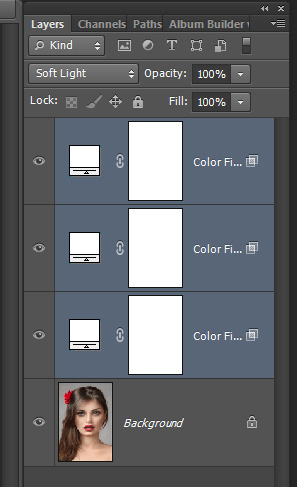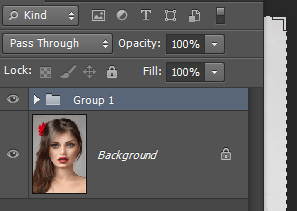In this lesson I’ll show you how you can convert a forest
into a dark, foggy, ominous scene. You’ll learn how to work with shadows,
lighting, adjustment layers, layer masks, dodge & burning and much more.
Let’s get started
What you will be creating
Here’s look at the outcome you’ll be able to produce by the
end of this lesson:
Step 1
Create a New document by selecting file>new and use the
settings shown in the image below.
Step 2
Now, place the forest image by selecting file>place then
select the forest image to place it.
Step 3
I added a layer mask to forest layer by clicking second
button on the layer panel then choose Gradient tool by pressing (G) on the
keyboard. Choose the black and white gradient and apply it vertically from top
to bottom. You can see the results on layer mask how I apply it.
Step 4
Now, I added a curves adjustment layer (settings below), and
clipping it to my forest layer using a clipping mask.
Choose a soft round black brush by pressing (B) on the
keyboard then paint on the layer mask of curves adjustment layer to hide the
selected effect.
Step 5
Now, place the sky image below your forest layer as shown in
the image below:
Step 6
I added a solid color adjustment layer to the sky. Here are
the values for this layer.
Step 7
Reduce the opacity of the solid color adjustment layer to
25% and also paint black on the layer mask of the solid color adjustment layer
to hide effect (see the bottom right of the below image to see where I’ve applied
this mask):
Step 8
I added Photo filter and Gradient Map Adjustment layers to
the sky. I also painted on the layer mask of both adjustment layer to hide the
effect in certain places. See the image below for the setting and layer mask
results.
Step 9
Change the blend mode of Gradient map to Multiply and reduce
the opacity to 70%.
Step 10
I added a color balance adjustment layer top of all the
layer and painted on the layer mask of it with soft round black brush to hide
the effect a bit.
Step 11
Add a Gradient map adjustment layer and paint on the layer
mask to hide the effect of gradient map adjustment layer.
Step 12
Change the blend mode of the Gradient adjustment layer to
soft light and reduce the opacity to 53%.
Step 13
Create a New layer by pressing Ctrl+Shift+N on your keyboard
then Grab the brush tool and change the color to #25344d. Then paint it with
opacity and flow to 30%
Step 14
Now, change the blend mode to multiply and reduce the
opacity to 50%.
Step 15
Create a new layer to make a light source then name it
‘Light source’.
Pick the soft round brush tool with opacity and flow to
100%, set the color to #286fbe and size to 2000 pixels. Paint two big strokes
on the center and reduce the size of the brush to 700 pixels, change the color
to #65aeff then again paint it on the mid.
Step 16
I added a layer mask to the light source layer and paint it
with soft round black brush to hide it a bit not too much. You can see the
results below how I have done it.
Step 17
Now, change the blend mode to Linear Dodge and reduce the
opacity to 63%.
Step 18
Extract the grave with your favourite selection tool then
place it here:
Step 19
I applied a blending options effect to the grave. To apply
it right click on the grave layer then choose blending options. Here are the
values for blending options effect.
Here are the results after applying the Gradient Overlay
effect.
Step 20
Next, I added curves and gradient map adjustment layer to
the grave to blend it to the scene. Here are the values for the both adjustment
layer.
Then change the blend mode of Gradient Map Adjustment layer
to Color and reduce the opacity to 71%.
Step 21
In this step we’ll use the Dodge tool to dodge the part of
the grave which reflected by our light source. Before using it, create a new
layer and then go to Edit>fill and fill it 50% gray then change the blend
mode of this layer to overlay.
Now Select the Dodge tool by pressing (O) on the keyboard
and set the exposure to 12% and range to midtones. Then dodge the part of the
grave as shown in the image below.
Step 22
Now, place the bush 1 image to the left bottom corner .
Step 23
Now, Go to Filter>Blur>Gaussian Blur and set the
values.
Step 24
To blend the bush to the scene I applied a Hue/Saturation
adjustment layer to the bush.
Step 25
Now, place bush 2 image to the scene as shown in the image
below.
Add a layer mask to bush 2 and Hide the selected part as
shown in the image by painting it with soft round black brush.
Step 26
I applied the Gaussian Blur filter and Hue/Saturation
adjustment layer to bush 2 with same setting as applied in 24 & 23 Step.
Step 27
Let’s create some fog. To do this, create a new layer and
fill it with black. Then change your foreground colour to #5b5a5a and
background colour to #000000. Now, go to Filter>Render>Clouds and when
you done it. You should achieve the results shown below. Name this layer ‘fog’.
Change the blend mode of fog layer to screen and reduce the
opacity to 15%. Add a layer mask to fog layer and hide the effect of fog.
Step 28
Extract the model and place it here. The white arrow
indicates that I kept the some leaves on the model layer, but don’t worry about
it we’ll fix this in next couple of steps:
Step 29
I applied a blending option effect to the model.
I created a new layer below the model layer and used a soft
round black brush with opacity and flow to 30% to paint some shadows as shown
in the image below:
Create a new layer again below the model layer and paint
some more shadows.
Step 30
Reduce the lightness of the model by applying a
Hue/Saturation adjustment layer. As you can see by reducing the lightness the
leaves which I kept on model are now blended properly.
Step 31
Continue blending the model to the scene by applying a
Exposure and Gradient Map adjustment. See the image below for values:
I changed the blend mode of Gradient Map adjustment layer to
‘Color’ and reduce the opacity to 50%.
Step 32
I applied the dodge and burn effect to the model. Create new
layer and fill it with 50% gray. Change the blend mode to overlay. Now, select
the Dodge and Burn tool then set the exposure to 12% and range to midtones.
Then start dodge and burning:
Step 33
I painted some light on the model. To do this create a new
layer and select the brush tool then set to opacity and flow to 30%. Now the
change your foreground color to #173737 and paint some light on model.
Set the blend mode to color dodge and here are the results:
Step 34
I painted some more light rays with the same settings as in
previous steps but changed the color to #0a1826:
Then set the blend mode to color dodge and reduce the
opacity to 60%;
Step 35
Extract the crow and place it on the the grave:
Step 36
Apply the following blending options to the crow:
Step 37
I painted shadows for the crow like I painted the shadows
for the model:
Step 38
Then, I applied a Gradient Map adjustment layer to the crow
to match it color to the scene.
Step 39
We’ve completed our main blending and it’s time for final
adjustments.
We’ll apply a series of adjustment layer to the entire
scene. Add the Photo filter and Gradient Map adjustment layer to the scene
first and see the image below for values. Change the blend mode of Gradient Map
to color dodge then I painted with soft round black brush on the layer mask of Gradient
Map adjustment layer.
Step 40
Now, I added a color balance adjustment layer to the scene
and see the below image for the values.
Step 41
I added two more adjustment layer to the scene which is a
Color Lookup and a Curves adjustment layer. I changed the blend mode Color
Lookup to soft light then reduced the opacity to 30%.
Step 42
For the final step, we’ll apply a lighting filter to the
scene. First of all create a new layer then press Ctrl+Shift+Alt+E to stamp all
the layers in one layer. Now, go to Filter>Render>Lighting Effect then
set the Hotspot as shown in the image below.
Here are the values of Lighting effect filter:
Congratulations, You’re All Done!
Awesome job making it this far! You should be proud of what
you’ve created. Show it off to your friends and colleagues and get some
feedback.
You can also comment here with your version, or any
questions you had about the techniques used. We love to see what you guys
create and we’re always here to give helpful feedback and tips to help you to
improve.





.jpg)
.jpg)
.jpg)
.jpg)
.jpg)
















